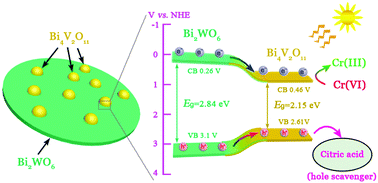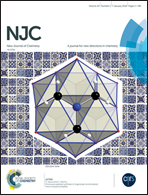Construction of the Bi2WO6/Bi4V2O11 heterojunction for highly efficient visible-light-driven photocatalytic reduction of Cr(vi)†
Abstract
Herein, a Bi2WO6/Bi4V2O11 heterostructured photocatalyst was fabricated through a facile one-pot solvothermal method. In this heterojunction system, highly homogeneous-dispersed Bi4V2O11 nanocrystals were anchored onto Bi2WO6 nanoflakes, endowing the heterojunction with nanosized interfacial contact. Because of the favorable interfacial contact and band alignment, photoinduced charge carrier transfer is facilitated in the Bi2WO6/Bi4V2O11 heterojunction, which can be verified by photocurrent and photoluminescence measurements. In contrast with pristine Bi2WO6 and Bi4V2O11 samples, the Bi2WO6/Bi4V2O11 heterostructured photocatalyst displays drastically improved photocatalytic Cr(VI) reduction activity under visible-light irradiation. More significantly, the as-fabricated heterojunction possesses superior activity for Cr(VI) relative to the counterpart obtained by mechanical mixing, indicating that the interfacial contact plays a determinant role in promoting charge carrier transfer. Moreover, Bi2WO6/Bi4V2O11 heterojunctions exhibited good cycling stability even after 5 cycles. A plausible photocatalytic Cr(VI) reduction reaction mechanism over the Bi2WO6/Bi4V2O11 heterojunction is proposed on the basis of band alignment. This work reports a high-efficiency photocatalyst for Cr(VI) and might shed light on the decisive factor for optimizing the heterostructure.



 Please wait while we load your content...
Please wait while we load your content...